Late Blight Disease Management: Before It Becomes A Serious Problem
As early as February 2012, moderate to severe levels of late blight have been reported from Florida. The strains of the fungus from Florida are reported to be changing and appear to be more tolerant to warmer temperatures. Florida supplies tomato seedlings to a large portion of the US. These two facts could have an impact on the late blight development and progress in 2012. The distribution of late blight disease could depend on how effective the surveillance for late blight is and also the weather in general.
Inspection of the greenhouse tomato transplants has to-date shown no infected plants in Manitoba in 2012.
In 2010, there was an early onset of late blight in June and later that summer there was a major problem on tomatoes and potatoes across the Canadian prairies. Late blight devastated tomato plants in many home gardens throughout Manitoba. The pathogen strains were US#23 (mostly on tomato, some potato) and US#24 (mostly potato). However, the story in 2011 was very different - late blight disease in Manitoba was at moderate levels on potato, while the tomato crop escaped almost unaffected. The late blight fungus strain was mostly US#24. This suggests that the population of late blight strains in Manitoba is dynamic and variable. Strains active in other regions of North America, especially just south of the border, could affect what we see here in Manitoba.
Development of late blight is very much weather dependent. MAFRD is involved in the running of a Weather Network, which is used for late blight forecast. However, there can be no disease if the inoculum is absent. For this reason, it is critical to start with potato seed or tomato transplants that are free of late blight. To increase the chances of avoiding late blight infection in 2012, it is important to understand the disease and to be able to identify it early.
Late blight is caused by a moisture-loving fungus, Phytophthora infestans, which can infect potato and tomato, as well as other related plants like nightshade, petunia and tomatillo. The fungus is changing and newer strains are appearing at a higher frequency. Some of these new strains may not affect all host crops with the same aggressiveness, i.e. tomatoes and potatoes may not show the same severity if infected with the same strain, while other strains may equally affect tomatoes and potatoes. Manitoba is part of a National Late Blight Working Group, which coordinates strain identification in various parts of Canada.
Identification Of Late Blight
In the early stages of infection the disease appears as water-soaked grey-green lesions on leaves and/or stems, often accompanied with light green discoloration around the darker area. Under conditions of high humidity, the fungus produces spores on the underside of leaves, which appears as a white mildew-like growth on the leaves and stems. As the tissue dies, it turns grey to brown and dries up within a few days. Late blight spores are microscopic and are spread both by splashing rain and wind. The spores can travel many miles in wind-swept rainstorms. After such storms, if the late blight inoculum is present, the new infections would usually develop in areas where the plants stay wet longer, in wind-protected areas, low lying spots or other topography that slows drying of plant leaves.
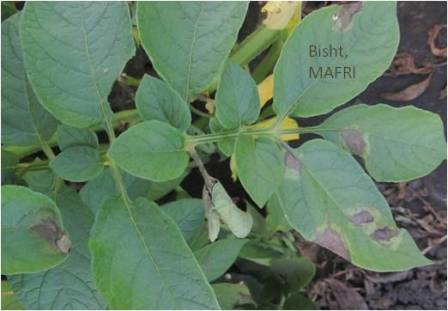
Late blight infections on potato leaves. These are rapidly growing spots in the crop canopy where humidity is high.

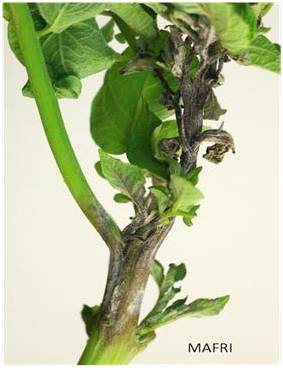
Infection on potato stems showing sporulation in water soaked areas.
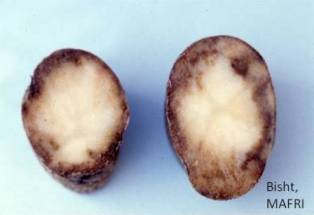
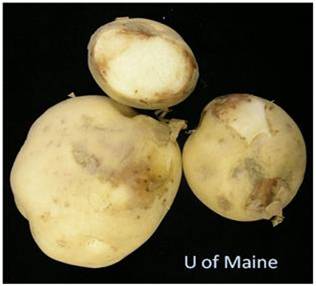
Infected potato tubers showing rusty-brown discoloration under the skin. While severely infected tubers rot and can be easily graded out, the lightly infected tubers often survive storage and can initiate new infections in the next season.
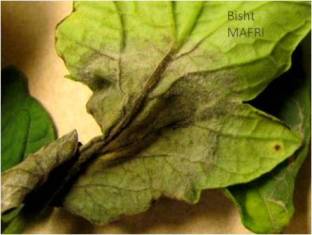
Close up of a leaf with water soaked rot on tomato petiole and sporulating white mildew on the underside of leaf.
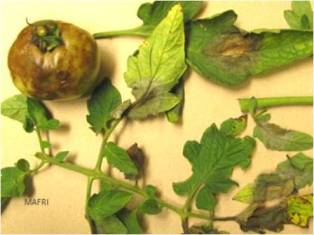
Late blight infected tomato leaves and fruit
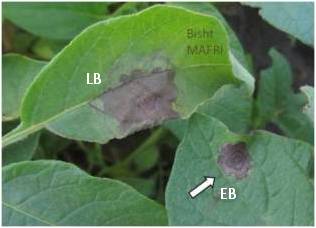
Early blight (EB) on potato
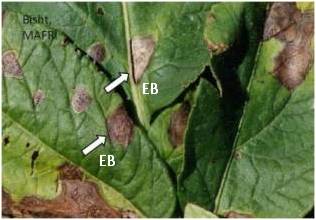
Early blight (EB) on tomato
Early blight: Concentric rings in spots and often not crossing the veins; while the late blight (LB) spots are not restricted by veins.
Both tomato and potato plants growing in the field or garden should be checked for late blight symptoms – on leaves, stems and fruits. Also, check petunia, tomatillo and nightshade weed plants for infection. Sometimes the spots may not be of late blight disease – if there are concentric rings of light and dark brown circles, often not crossing the veins, and spots do not have white sporulation on the underside of the leaves even under high humidity - the disease symptoms could be early blight. Early blight, caused by fungus Alternaria species usually appears when the plants are nearing the end of season or on plants with nutrient stress but it is usually not as devastating as late blight.
How to manage late blight?
- Buy certified seed potatoes to reduce the risk of introducing late blight.
- Bury culled potatoes; do not throw them on the compost pile.
- Select tomato seedlings that appear healthy for your home garden.
- Keep a close watch on your tomato and potato plants during the growing season.
- Preventative fungicide sprays may be applied if late blight is present in your neighbourhood.
- Remove plants that show symptoms of the disease. Infected plants should be dug up, destroyed and disposed of properly to prevent the disease from spreading.
Commercial potato growers and greenhouse tomato producers have access to a number of commercial fungicides for late blight management (Guide to Field Crop Protection and Guide to Vegetable Crop Protection, published by MAFRD). The choice is limited for home gardeners. As a preventative measure, four compounds are registered for domestic use in home-gardens (non-commercial use) as protectant fungicides. All are copper-based:
- King ECO-Way PTV Potato, Tomato & Vegetable Fungicide Spray. (Wettable Powder)
- King PTV Potato, Tomato & Vegetable Dust for Bugs and Blights (Insecticide/Fungicide Dust)
- Green Earth BORDO Copper Spray (Wettable Powder)
- Wilson Garden Doctor Insecticide/Fungicide (Dust formulation)
Contact your local home & garden centers for these products. These products are protectant sprays or dusts only and WILL NOT “CURE” late blight once it is present on a plant. ALWAYS read and follow directions on the pesticide label.
In a home-garden, if late blight is present on plants, the recommendation is to remove those plants and dispose of them properly. This will reduce the risk of transferring the disease to healthy susceptible plants in and around the neighbourhood. If late blight infected plants are thrown out or composted, they can continue to produce spores, which may be carried by the wind and drift onto other susceptible plants in the area. For this reason DO NOT COMPOST diseased plants.
Carefully remove the diseased plants and put them in plastic bags. Double-bagging the diseased material with plastic helps keep the spores from spreading. Set the bags in the sun to heat the infected material inside enough to kill the plants.
Plants suspected of being infected with late-blight can be sent for diagnosis to MAFRD’s Crop Diagnostic Lab, 545 University Crescent, Winnipeg, MB or your local MAFRD GO office. Non-commercial growers are subject to a $10.50 fee. Samples should be packaged so as to not dry up, using paper bags or polythene bags with breathing holes and be sent or delivered to lab in a timely manner. Samples in polythene bags, with no breathing hole will rapidly rot in warm conditions!
You may also take digital photos of the suspected diseased plants and email to Dr. Vikram Bisht, Potato and Horticulture Crops Pathologist, vikram.bisht@gov.mb.ca, for consultation on identification and management options.
References:
- http://usablight.org/ February 17, 2012: Late blight update in Florida: Showing up in Gulf Coast tomato and potato production area.
- Late Blight in Tomatoes
- Late Blight in Potatoes

